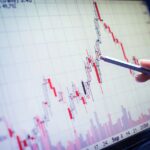Range trading is a popular trading strategy that involves buying at the bottom of a defined price range and selling at the top of the range. This strategy is based on the belief that markets tend to move within a particular price range for an extended period before breaking out to either the upside or downside. Range trading requires a good understanding of market conditions and technical analysis skills to identify patterns and trends.
This comprehensive guide provides a deeper understanding of this, from identifying a trading range to effective strategies for trading within a range, and risk management techniques.
Identifying: Key Indicators
Identifying a trading range is critical to this strategy. The first step is to identify a chart pattern that shows a horizontal price range. The next step is to identify key indicators that can help confirm the trading range.
Bollinger Bands are a technical indicator that traders use to identify potential trading ranges. These bands are plotted two standard deviations away from the moving average and can help traders spot overbought and oversold conditions within a range.
Another essential indicator for it is the Relative Strength Index (RSI). This indicator measures the magnitude of price movements and can help traders identify potential overbought and oversold conditions within a range.
Strategies for Trading Within a Range
Once a range is identified, traders can use various strategies to profit from range trading. One of the most common strategies is to buy at the bottom of the range and sell at the top. Another strategy is to sell at the top of the range and buy at the bottom.
Traders can also use breakout strategies to profit from range trading. This strategy involves buying when the price breaks above the range’s resistance level or selling when the price falls below the range’s support level.
Risk Management and Exiting a Range Trade
Risk management is crucial when range trading. One of the essential risk management techniques is to use stop-loss orders to limit losses in case the price breaks out of the range. Traders should also avoid trading during volatile market conditions that can lead to unpredictable price swings.
Exiting it involves taking profits or cutting losses when the price breaks out of the range. Traders should use technical analysis to identify potential breakout levels and set stop-loss orders accordingly.
This Strategy is a highly effective day trading strategy that is widely used by traders to capitalize on the price movements of stocks that tend to remain within a certain range. If you are new to this trading strategy or want to learn more about it, then this comprehensive guide is for you. In this article, we will cover everything from understanding the day trading strategy, what is an average true range in trading, how to find range trading stocks, whether this strategy is profitable or not, and how to calculate range in trading.
Understanding The Daily Range Day Trading Strategy
The daily range day trading strategy is a simple yet effective approach that involves buying stocks at the bottom of the range and selling them at the top of the range. The idea behind this strategy is that stocks tend to move within a certain price range over a given period. By identifying the high and low points of the range, traders can buy and sell stocks at the most opportune times.
What Is An Average True Range In Trading?
The average true range (ATR) is a technical indicator that measures the degree of price volatility of a stock over a given period. It helps traders to determine the range within which a stock is likely to move. The ATR is calculated by taking the average of the true range of a stock over a certain period. The true range is the largest of the following:
- The high minus the low,
- The absolute value of the high minus the previous close,
- The absolute value of the low minus the previous close.
How To Find Range Trading Stocks?
To find, you need to look for stocks that have a tendency to move within a certain price range. These stocks can be identified by analyzing their historical price charts and identifying the high and low points of their range. You can also use technical indicators such as Bollinger Bands, Moving Averages, and Relative Strength Index (RSI) to identify potential stocks.
Is Range Trading Profitable?
It can be a profitable strategy if executed correctly. However, it requires a lot of patience and discipline as stocks can remain within a range for an extended period. Traders who follow the this strategy need to be vigilant in monitoring the stock’s price movements and identifying the high and low points of the range accurately. Additionally, traders need to have a well-defined exit strategy and risk management plan in place to protect their profits.
How Do You Calculate Range In Trading?
To calculate the range in trading, you need to identify the high and low points of a stock’s price movements over a given period. Once you have identified the high and low points, you can calculate the range by subtracting the low from the high. For example, if the high of a stock is $50, and the low is $40, then the range is $10.
In conclusion, range trading is a popular day trading strategy that can be used to generate profits in the stock market. By understanding the daily range day trading strategy, the average true range in trading, how to find stocks suitable for this strategy, whether it is profitable or not, and how to calculate range in trading, traders can develop an effective range trading strategy. However, it is essential to note that it requires discipline, patience, and a well-defined exit strategy to be successful.













